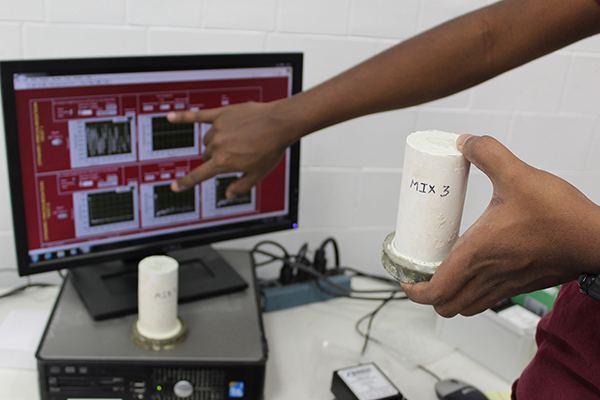
Nuclear waste is a reality, whether remnants of nuclear weapons or the byproducts of nuclear power plants. While we aren’t at risk of an attack from a giant radioactive lizard, nuclear waste can still pose threats to human health.
Dr. Zachary Grasley, an associate professor in the Zachry Department of Civil Engineering at Texas A&M University, conducted experiments for the Savannah River National Lab (SRNL) in hopes of preventing nuclear waste leakage. The waste in question is relatively harmless, especially compared to what we see in comic books and movies, but it is a waste that must be safely disposed of. The best way to safely store and contain this nuclear waste is by mixing it into a cement grout and storing it in large concrete vaults.
Grasley’s research concerns the permeability of these grout mixtures and in turn, the ability for nuclear materials to eventually flow through the solidified grout and into the environment. The SRNL contracted Grasley to run these experiments because of his state-of-the-art permeability testing method. What once took weeks to test can now be accomplished in minutes with this test developed at Texas A&M. The original construction of the system was funded directly by the Texas A&M Engineering Experiment Station.
"I developed a prototype of the permeability measurement system as a Ph.D. student at the University of Illinois at Urbana-Champaign. I then built a more advanced, second generation with dual testing capabilities, both hollow and solid cylinders, once I arrived at Texas A&M," said Grasley.
These tests involve taking hollow or solid cylinders of various grout samples developed by SRNL, saturating them with water and subjecting them to high levels of water pressure inside of a pressure vessel. Immediately after, the pressure on the surface of the sample equalizes to the pressure the vessel was subjected to, causing the material to contract. The pressure level inside the sample remains much lower, however, because the solid structure of the grout is bearing most of the pressure. Because liquids flow from high pressure areas to lower pressure areas, water will begin to flow into the pore network of the sample if the pressure is sustained. As water permeates the material, it begins filling the pores in the sample, causing it to expand and regrow.
The rate at which the sample expands after the initial contraction allows for an accurate calculation of the permeability of the sample. This process takes less than an hour, compared to previous testing techniques that could take weeks to complete.
By developing this testing method, Grasley has significantly reduced the time and effort required to understand the permeability of these different grout mixtures produced by the SRNL. This means previously unknown information about these samples can now be determined in minutes. As the SRNL produces various grout mixtures containing nuclear waste materials, it is vital to understand the rate at which the nuclear materials can escape from them.
“This is actually pretty critical because it turns out that small changes in the mixture can cause an order of magnitude change in permeability,” said Grasley. “That is important because if you have an order of magnitude change in permeability, it leads to an order of magnitude change in the time scale that it takes for the material to leach out.”
An integral part of Grasley’s research team is Ph.D. student Jeffryd Rose, who was responsible for the actual testing and reporting of the project. This project fit with Rose’s doctoral research, which focuses on measuring permeability of cement based materials.
“As a part of my Ph.D. research, I built a setup to measure the permeability of cement based materials, so measuring materials with similar composition was a great application of my own research,” said Rose. “This project offered me the opportunity to apply my research to a practical problem, going beyond theory, which is why this research project was so important and meaningful to me.”
Rose expects to graduate from his doctoral program after completing the fall semester of 2017. Rose’s findings were sent to SRNL to evaluate and apply to future waste containment methods.
This research is a matter of both environmental safety and human health. The goal is to find the best way to contain these potentially harmful materials to ensure that they do not leak into the environment, groundwater or surface water. The test Grasley developed, and his collaboration with SRNL, are ensuring the safe disposal of nuclear waste and continuing to open doors for further exploration of nuclear energy.
Contributing author: Ryan Terry
